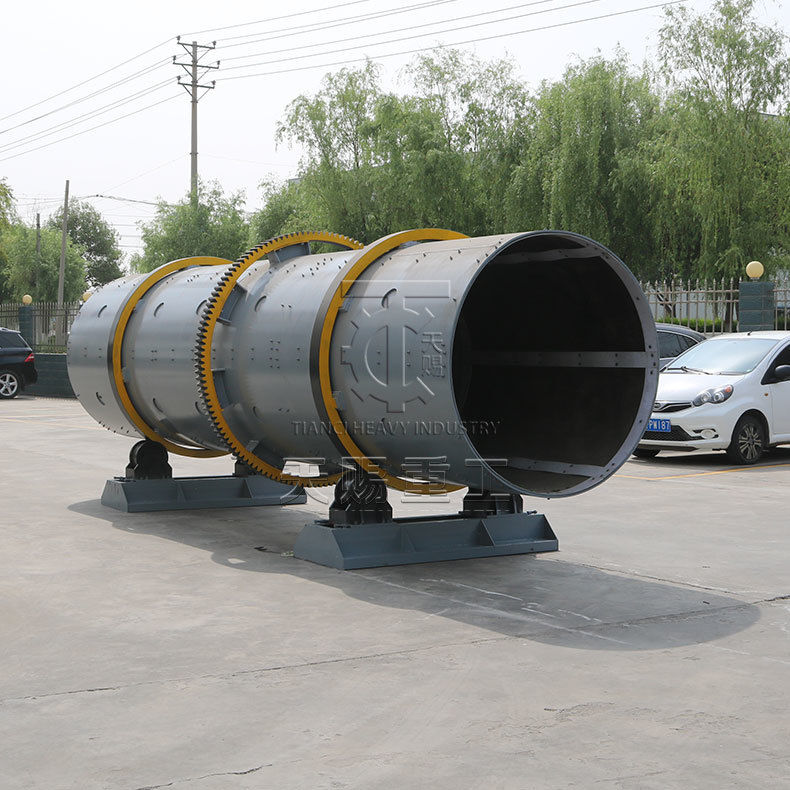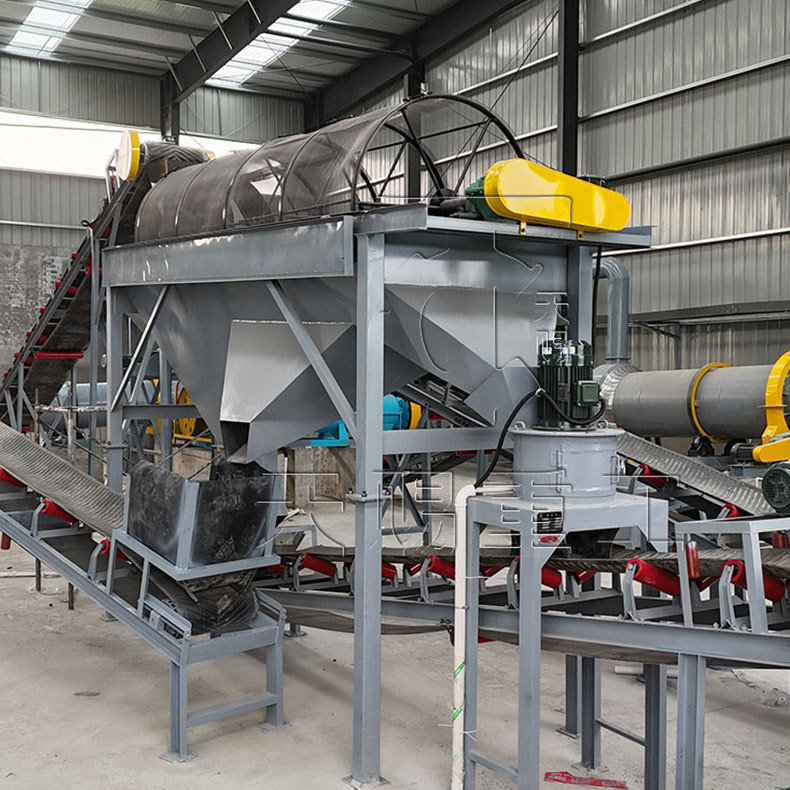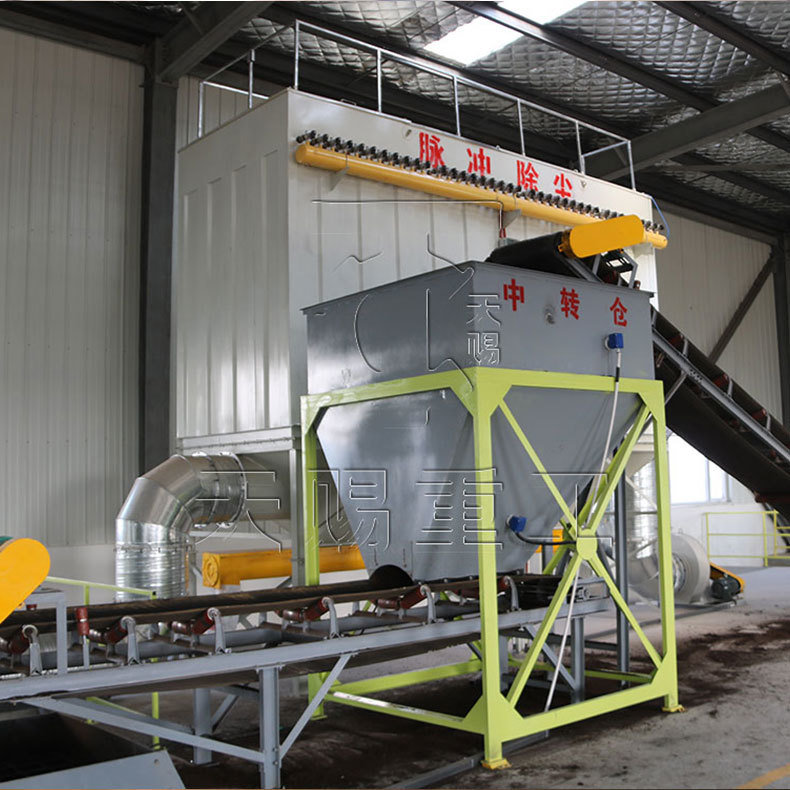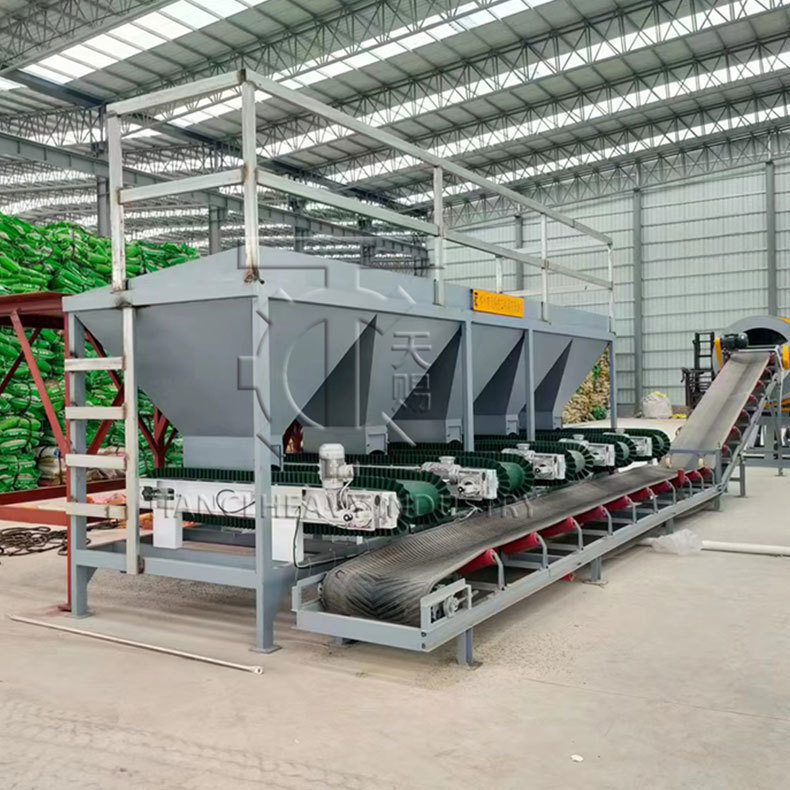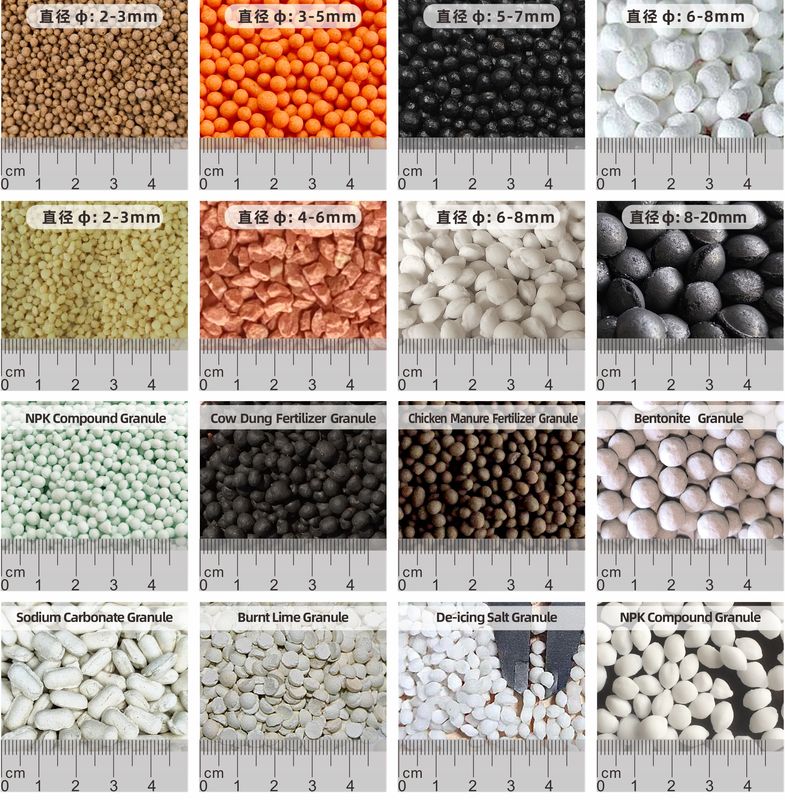Overall Overview of the Production Line
This compound fertilizer granulation production line aims to meet the agricultural demand for high-efficiency, high-quality compound fertilizers. It is designed to produce 50,000 tons of fertilizer annually, with a nitrogen content of 20%, potassium content of 15%, and urea content of 40%. The production line uses a rotary drum granulator as its core granulation unit, complemented by complete equipment for batching, crushing, mixing, coating, drying, cooling, screening, return material processing, packaging, and palletizing, forming a continuous, efficient, and stable automated production line. The entire production line adheres to a green, environmentally friendly, energy-saving, and consumption-reducing design philosophy. While ensuring product quality, it minimizes energy consumption and environmental pollution, making it widely applicable to large-scale fertilizer production enterprises and providing strong material support for the modernization of agriculture.

Detailed introduction of core equipment
Rotary drum granulator (granulation main unit)
The rotary drum granulator is the core equipment of this compound fertilizer granulation production line, responsible for turning uniformly mixed materials into granular products that meet the requirements. The drum of this rotary drum granulator is made of high-quality stainless steel, possessing excellent corrosion resistance and wear resistance, and a long service life. The rotation speed and tilt angle of the drum can be adjusted according to the material characteristics and particle size to ensure granulation effect and particle quality. During the granulation process, the mixed materials continuously tumble and agglomerate inside the drum, gradually forming particles with a diameter of 2-4mm, achieving a particle forming rate of over 90%. Simultaneously, the rotary drum granulator is also equipped with a spraying device, which can spray appropriate amounts of water or binder into the drum as needed to further improve the strength and stability of the particles.
Coating machine and liquid coating tank
The coating machine and coating liquid tank work together to coat compound fertilizer granules after granulation, improving their resistance to moisture absorption, caking, and storage stability. Trace elements or pesticides can also be added during the coating process, making it multifunctional. The coating machine uses a drum-type structure; the granules tumble continuously inside the drum as it rotates, and the coating liquid is evenly sprayed onto the granule surface through a dedicated spraying device, forming a uniform coating. The coating liquid tank is used to store and prepare the coating liquid, and is equipped with a stirring device to ensure the uniformity of the coating liquid composition. The coating machine achieves a coating uniformity of over 98%, and the coated granules are less prone to moisture absorption and caking during storage, effectively extending the product's shelf life.
Dryer
The dryer is used to dry compound fertilizer granules with high moisture content after granulation, reducing the moisture content to meet product quality standards (typically ≤2%). This production line uses a rotary dryer, which uses hot air as the drying medium and evaporates the moisture from the granules through heat exchange. The dryer's drum is made of high-quality steel plate, with lifting plates on the inner wall to continuously lift and drop the granules, increasing the contact area between the granules and the hot air and improving drying efficiency. The heat source for the dryer can be selected from coal-fired hot air furnaces, gas-fired hot air furnaces, or biomass hot air furnaces, depending on the actual situation, ensuring stable heating and high thermal efficiency. The equipment is also equipped with a temperature control system that monitors the drying temperature in real time, ensuring a stable drying process and preventing granule deterioration due to excessive temperature.
Cooling machine
The cooler is used to cool compound fertilizer granules that have been dried to a high temperature (typically 80-100℃), reducing their temperature to near room temperature (≤40℃) to facilitate subsequent screening and packaging processes. The production line uses a rotary cooler, similar in structure to a rotary dryer, but with the opposite working principle. It uses cold air as the cooling medium, removing heat from the granules through heat exchange. The cooler has high cooling efficiency, cooling the granules to the required temperature in a short time with uniform cooling, preventing localized overheating or underheating. The cooled granules are harder, less prone to breakage, and effectively ensure product quality.
Screening machine
The screening machine is used to classify and screen the cooled compound fertilizer granules, selecting granules with a qualified particle size (2-4mm) as the finished product, and separating granules that are too large (greater than 4mm) and powders that are too small (less than 2mm) for further processing. This production line uses a vibrating screen, which has the advantages of high screening efficiency, accurate grading, and low noise. The screen is equipped with multiple layers of screens, enabling multi-stage screening of granules simultaneously. Qualified granules pass through the screens and enter the finished product conveying system. Particles with an excessively large particle size are conveyed to a return crusher for further crushing, while powders with an excessively small particle size are returned to the mixer to participate in mixing and granulation again, realizing the recycling of materials, improving raw material utilization, and reducing production costs.
Return material crusher
The return material crusher is mainly used to re-crush excessively large compound fertilizer granules separated by the screening machine, making them suitable for re-mixing and granulation. This return material crusher uses the same type of hammer mill as the raw material crusher, but its crushing parameters can be adjusted according to the characteristics of the return material to ensure crushing effect. The processing capacity of the return material crusher matches the overall capacity of the production line, and can promptly handle the return material generated by screening, ensuring the continuous and stable operation of the production line.
Packaging machines and robotic palletizers
1. Packaging Machine : The packaging machine is used to automatically package qualified compound fertilizer granules according to specified weights (such as 25kg/bag, 50kg/bag, etc.), facilitating product storage, transportation, and sales. This production line uses an automatic quantitative packaging machine, which has the advantages of accurate measurement, fast packaging speed, and high degree of automation. The packaging machine realizes automatic measurement, filling, and sealing of materials through sensors and control systems. The measurement accuracy can reach ±0.2%, and the packaging speed can reach 60-80 bags/hour. Packaging materials can be selected from plastic woven bags, paper bags, or composite bags to meet the packaging needs of different customers.
2. Robotic palletizers : Robotic palletizers are used to automatically stack packaged compound fertilizer bags onto pallets according to a preset stacking pattern, achieving automated stacking of finished products. This robotic palletizer adopts a multi-joint robot structure, offering flexible movement, accurate positioning, and high stacking efficiency. The robot can automatically adjust the stacking method and pattern according to the specifications of the finished bags and the size of the pallet, achieving a stacking accuracy of ±5mm and a stacking speed of 100-120 bags/hour. The application of robotic palletizers not only improves stacking efficiency and reduces manual labor intensity but also ensures the stability and neatness of the stacking, facilitating subsequent warehousing and transportation.
Conveyors and silos
1. Conveyors : Conveyors are crucial links connecting various equipment on the production line, responsible for transporting materials between processes and ensuring continuous operation. This production line is equipped with various types of conveyors, such as belt conveyors, screw conveyors, and bucket elevators, depending on the different conveying scenarios and material characteristics.
◦ Belt conveyors are mainly used for horizontal or inclined conveying of granular or powdery materials, such as raw materials from raw material silos to crushers, and finished products from packaging machines to robotic palletizers. Belt conveyors have advantages such as large conveying capacity, long conveying distance, stable operation, and low noise. The belts are made of high-strength rubber and have a long service life.
◦ Screw conveyors are mainly used for conveying powdery or small granular materials, such as materials crushed by a return crusher being returned to a mixer. Screw conveyors have a compact structure, small footprint, and good sealing performance, effectively preventing material leakage and dust pollution.
◦ Bucket elevators are mainly used for vertically conveying granular materials, such as mixing materials from mixers to rotary drum granulators, and dried granules from dryers to coolers. Bucket elevators have advantages such as high lifting height, large conveying capacity, and reliable operation. The buckets are made of wear-resistant materials, ensuring a long service life.
Material silos : Material silos are used to store raw materials, intermediate products, and finished products required for each stage of the production line, ensuring continuous and stable material supply and storage. This production line is equipped with multiple silos of different types and specifications, such as raw material silos, mixed material silos, and finished product silos. All silos are constructed of welded steel structures with smooth inner walls, preventing material buildup and facilitating material flow and unloading. Each silo is equipped with a dust cover at the top and a unloading device (such as a rotary valve or electric gate) at the bottom, allowing control of the unloading volume and speed according to production needs. Additionally, each silo is equipped with a level gauge to monitor the inventory level in real time, facilitating production scheduling and raw material procurement.


Technical Advantages of the Production Line
1.High degree of automation : The production line adopts a PLC control system, which realizes the full-process automated operation from raw material batching, crushing, mixing, granulation, drying, cooling, screening, coating, packaging to palletizing, reducing manual intervention and improving production efficiency and product quality stability.
2.High-quality products : Through a precise batching system, efficient mixing equipment, advanced rotary drum granulation technology, and perfect screening and coating processes, we ensure that the compound fertilizer granules produced have uniform nutrients, moderate particle size, high strength, good resistance to moisture absorption and caking, and meet the needs of agricultural production for high-quality compound fertilizers.
3.Low energy consumption : All equipment selected for the production line adopts energy-saving design. For example, the high-efficiency dryer and cooler adopt an optimized heat exchange structure, which improves thermal efficiency and reduces energy consumption. At the same time, the recycling of materials (such as returning materials to be crushed and re-granulated, and screening powder to be returned to mixing) improves the utilization rate of raw materials and reduces waste.
4.Excellent environmental performance : The production line is equipped with sealing devices and dust removal equipment at each dust-generating stage (such as crusher, mixer, screening machine, etc.), which effectively controls the escape of dust; during the drying process, a high-efficiency exhaust gas treatment device is used to reduce the emission of harmful gases, meet national environmental protection standards, and improve the production environment.
High flexibility : The equipment parameters of the production line (such as the rotation speed and tilt angle of the drum granulator, the temperature of the dryer, and the packaging weight of the packaging machine) can be flexibly adjusted according to different raw material characteristics and product requirements, enabling the production of compound fertilizer products of various specifications and nutrient contents to meet the needs of different customers.
Support and Services
At Tianci Heavy Industry Machinery, we are committed to providing complete support and services to ensure every customer achieves the best results from our equipment. From project planning to after-sales maintenance, our team offers professional assistance at every stage.
1. Pre-sales Consultation
We help customers choose the most suitable machines according to their materials, capacity, and production needs. Customized design and technical solutions are available to meet specific project requirements.
2. Installation and Training
Our experienced engineers can guide installation on-site or online. We also provide detailed operation manuals and training to ensure smooth and efficient production startup.
3. After-sales Service
We offer long-term technical support, quick spare parts supply, and regular maintenance guidance. Any issues are addressed promptly to minimize downtime and keep your production running steadily.
4. Global Support
With successful projects in over 200 countries, we understand the needs of different markets and provide reliable service wherever you are.
At Tianci, our mission is not only to deliver high-quality machines but also to build lasting partnerships through trust, professionalism, and continuous support.
Rotary Drum Granulator Frequently Asked Questions (FAQs)
Q: Could you please specify the hourly output range of your drum granulator?
A: The standard hourly output of our drum granulator ranges from 1 to 300 tons. If you have higher output demands (e.g., over 25 tons per hour), we can tailor a customized solution based on your specific production needs.
Q: HOW DOES A ROTARY DRUM GRANULATOR WORK?
A: A drum granulator works by tumbling material in the presence of a liquid binder to encourage granule formation and growth. Feed material and binder are constantly fed through the rotating drum. The rolling action, combined with the stickiness from the binder, causes fines to collect together into particles. These particles continue to pick up additional fines and binder as they tumble in the bed, causing them to densify and pick up additional layers in a phenomenon known as coalescence. Tumbling flights can be incorporated into the unit to increase agitation of the material bed.
This way of forming agglomerates is a type of agitation agglomeration also known as wet granulation, balling, or pelletizing.
Q: WHAT TYPES OF MATERIALS CAN A ROTARY DRUM GRANULATOR PROCESS?
A: Generally speaking, drum granulators can process any bulk solid in the form of a dry, fine powder. This flexibility lends well to a host of industries, processing materials ranging from specialty chemicals and fertilizers, to minerals and ores, and everything in between.
In some cases, the feedstock may require pretreatment in the form of crushing, grinding, or drying to be a suitable feed for the granulator and produce the characteristics desired in the end product.
Q: WHAT’S THE ADVANTAGE OF A ROTARY DRUM GRANULATOR OVER A DISC PELLETIZER?
A: In choosing between a drum granulator and a disc pelletizer, the drum is often chosen because it offers a higher throughput than the disc pelletizer. The rotary drum also has the advantage of being a “closed” system, meaning that granulation occurs inside a contained environment, so fugitive material is limited.
WHAT CAPACITIES CAN A GRANULATION DRUM ACCOMMODATE?
A: Granulation drums can be customized to nearly any size, accommodating capacities ranging from 500 lb/hr – 3500 TPH+.
ARE DRUM GRANULATORS BATCH OR CONTINUOUS?
A: Rotary drum granulators are typically employed in a continuous setting, though they may function as a batch device in some R&D environments, such as the TIANCI Innovation Center.
Q: WHAT IS THE RETENTION TIME OF A ROTARY DRUM GRANULATOR?
A: Retention time is one process parameter used to control the characteristics and quality of the material exiting the drum, so it can vary significantly depending on the process and product goals. In general, retention time in a granulator may fall anywhere between 30 seconds and 60 minutes.
Q: WHAT ARE THE TYPICAL WEAR ITEMS?
A: Rotary drum granulators are generally low maintenance, but some items can become worn, depending on the operating conditions, and particularly if the drum falls out of alignment. The most common wear items for a drum granulator typically include the liner (where applicable), tumbling flights (where applicable), and potentially trunnion wheels, tires, and thrust rollers.
Rotary drum alignment is an important aspect of drum maintenance to prevent wear of the tires and trunnion wheels. When a drum falls out of alignment, it puts added stress on all components, encouraging undue wear.
Q: DOES THE PRODUCT EXITING THE GRANULATOR REQUIRE DRYING?
A: Since the granulation process relies on a liquid binder to form and layer granules, the product exiting the granulator is wet and must be dried unless it is moving immediately to a downstream process that does not require drying (such as in the case of iron ore balling, where pellets go to a grate kiln).
Drying is typically carried out in a rotary dryer, which further rounds and “polishes” the granules as a result of the tumbling action that occurs as the drum rotates.
Q: HOW DO I KNOW IF A ROTARY DRUM GRANULATOR IS RIGHT FOR MY APPLICATION?
A: Whether or not a rotary drum granulator is the right fit for a given project depends on specific process and product goals, such as capacity, level of control over particle characteristics, product parameters, and more.
When it is not clear if a drum granulator will be able to meet the project objectives, testing can be carried out in the TIANCI Innovation Center to evaluate the process and identify the most suitable equipment configuration.
Q: IS ANY OTHER EQUIPMENT REQUIRED TO SUPPORT A ROTARY DRUM GRANULATOR?
A: Drum granulators require a feeding and offtake system to convey material into and away from the drum. They also typically require screens and a recycle circuit to recover overs and unders and recycle them back into the process
Drum granulators are also typically followed by a rotary dryer and in some cases, may be preceded by a mixer for providing a homogeneous feedstock to the unit.
Q: WHAT DOES THE DESIGN PROCESS LOOK LIKE?
A: Rotary drum granulator design typically begins with testing to assess the feasibility of granulating the intended material and to gather key process data such as percent fill, retention time, drum speed and slope, spray system design, and more.
Once the data has been gathered, engineers work off of this to size the drum and incorporate any necessary features or modifications needed to produce the desired product at the intended capacity.
Q: WHAT DATA IS NEEDED TO DESIGN A ROTARY DRUM GRANULATOR?
A: A variety of data points are necessary to design the granulator. Along with a process description, the follow data is typically required:
Why Choose Us?

Support and Services:
We are committed to providing our customers with comprehensive support and reliable services. Our company offers free process design drawings tailored to your needs, as well as free trial testing services to ensure optimal machine performance. Every machine comes with a one-year warranty for worry-free operation. In addition, we provide free installation and professional training services, helping your team quickly master the equipment and achieve efficient production.



 Your message must be between 20-3,000 characters!
Your message must be between 20-3,000 characters! Please check your E-mail!
Please check your E-mail!  Your message must be between 20-3,000 characters!
Your message must be between 20-3,000 characters! Please check your E-mail!
Please check your E-mail! 
